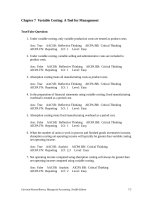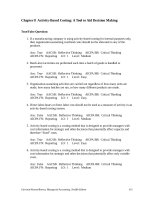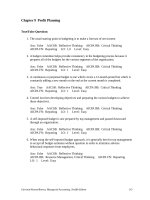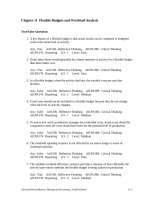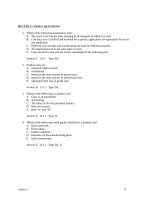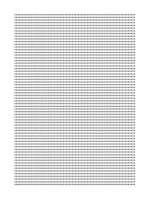Test bank managerial accounting by hilton 9e chapter12
Bạn đang xem bản rút gọn của tài liệu. Xem và tải ngay bản đầy đủ của tài liệu tại đây (169.79 KB, 35 trang )
MULTIPLE CHOICE QUESTIONS
1. When managers of subunits throughout an organization strive to achieve the goals set by top
management, the result is:
A. goal congruence.
B. planning and control.
C. responsibility accounting.
D. delegation of decision making.
E. strategic control.
Answer: A LO: 1 Type: RC
2. Which of the following is not an example of a responsibility center?
A. Cost center.
B. Revenue center.
C. Profit center.
D. Investment center.
E. Contribution center.
Answer: E LO: 2 Type: RC
3. A manufacturer's raw-material purchasing department would likely be classified as a:
A. cost center.
B. revenue center.
C. profit center.
D. investment center.
E. contribution center.
Answer: A LO: 2 Type: N
4. Hitchcock Corporation is in the process of overhauling the performance evaluation system for
its Los Angeles manufacturing division, which produces and sells parts that are popular in the
aerospace industry. Which of the following is least likely to be chosen to evaluate the overall
operations of the Los Angeles division?
A. Cost center.
B. Responsibility center.
C. Profit center.
D. Investment center.
E. The profit center and investment center are equally unlikely to be chosen.
Answer: A LO: 2 Type: N
Chapter 12
81
5. A cost center manager:
A. does not have the ability to produce revenue.
B. may be involved with the sale of new marketing programs to clients.
C. would normally be held accountable for producing an adequate return on invested capital.
D. often oversees divisional operations.
E. may be the manager who oversees the operations of a retail store.
Answer: A LO: 2 Type: N
6. The Telemarketing Department of a residential remodeling company would most likely be
evaluated as a:
A. cost center.
B. revenue center.
C. profit center.
D. investment center.
E. contribution center.
Answer: B LO: 2 Type: RC
7. If the head of a hotel's food and beverage operation is held accountable for revenues and costs,
the food and beverage operation would be considered a(n):
A. cost center.
B. revenue center.
C. profit center.
D. investment center.
E. contribution center.
Answer: C LO: 2 Type: RC
8. Which of the following would have a low likelihood of being organized as a profit center?
A. A movie theater of a company that operates a chain of theaters.
B. A maintenance department that charges users for its services.
C. The billing department of an Internet Services Provider (ISP).
D. The mayor's office in a large city.
E. Both "C" and "D" above.
Answer: E LO: 2 Type: N
82
Hilton, Managerial Accounting, Seventh Edition
9. Easy-to-Use Software operates stores within five regions. Regional
managers are held accountable for marketing, advertising, and sales
decisions, and all costs incurred within their region. In addition, regional
managers decide whether new stores will open, where the stores will be
located, and whether the stores will lease or purchase the facilities. Store
managers, in contrast, are accountable for marketing, advertising, and
sales decisions, and costs incurred within their stores. Ideally, on the basis
of this information, what type of responsibility center should the software
company use to evaluate its regions and stores?
Regions
Stores
A. Profit center
Profit center
B. Profit center
Cost center
C. Profit center
Revenue center
D. Investment center
Profit center
E. Investment center
Cost center
Answer: D LO: 2 Type: N
10. Decentralized firms can delegate authority by structuring an organization into responsibility
centers. Which of the following organizational segments is most like a totally independent,
standalone business where managers are expected to "make it on their own"?
A. Cost center.
B. Revenue center.
C. Profit center.
D. Investment center.
E. Contribution center.
Answer: D LO: 2 Type: N
11. A responsibility center in which the manager is held accountable for the profitable use of
assets and capital is commonly known as a(n):
A. cost center.
B. revenue center.
C. profit center.
D. investment center.
E. contribution center.
Answer: D LO: 2 Type: RC
12. The Asian Division of a multinational manufacturing organization would likely be classified
as a:
A. cost center.
B. revenue center.
C. profit center.
D. investment center.
E. contribution center.
Answer: D LO: 2 Type: N
Chapter 12
83
13. Performance reports help managers:
A. use management by exception and effectively control operations.
B. decide whether a cost, profit, or investment center framework is appropriate.
C. design their organizational hierarchy.
D. pinpoint trouble spots.
E. by assisting with functions "A" and "D."
Answer: E LO: 3 Type: RC
14. Consider the following statements about performance reports:
I.
II.
III.
Performance reports provide feedback to managers and allow them to better control
operations.
Many performance reports have budget, actual, and variance data.
Performance reports are often structured around a firm's organizational hierarchy—
that is, data relating to lower-level units (e.g., departments) are combined and flow into
higher-level units (e.g., stores).
Which of the above statements is (are) true?
A. I only.
B. I and II.
C. I and III.
D. II and III.
E. I, II, and III.
Answer: E LO: 3 Type: RC
15. Aloha Hotels owns numerous hotels on each of the Hawaiian Islands. The
company's performance reporting system is structured around the firm's
organizational structure, with information flowing from operating
departments at a particular property and later respectively grouped by
individual hotel, island operation (i.e., division), and the company as a
whole. Which of the following best depicts the detail level of the
information given to a department manager versus that reported to a
company vice-president?
Department Manager
Company Vice-President
A. Somewhat detailed
Somewhat detailed
B. Somewhat detailed
Somewhat summarized
C. Somewhat summarized
Somewhat detailed
D. Somewhat summarized
Somewhat summarized
E. None of the above because department managers do not receive performance reports.
Answer: B LO: 3 Type: N
84
Hilton, Managerial Accounting, Seventh Edition
16. Leisure Time owns six hotels in Hawaii, collectively known as the Hawaiian Division. The
various hotels, including the Surf & Sun, have operating departments (such as Maintenance,
Housekeeping, and Food and Beverage) that are evaluated as either cost centers or profit
centers. The Food and Beverage Department, for example, is a profit center, with activities
divided into three segments: Banquets and Catering, Restaurants, and Kitchen. If Leisure
Time uses a performance-reporting system that is based on responsibility accounting, which of
the following disclosures is likely to occur?
A. The detailed operating costs of the Surf & Sun's Kitchen Department will appear on the
Hawaiian Division's performance report.
B. The Food and Beverage Department's profit will appear on Kitchen's performance report.
C. The profit of the Surf & Sun hotel will appear on the Hawaiian Division's performance
report.
D. The Food and Beverage profit at the Surf & Sun will appear on Leisure Time's
performance report.
E. The profit of the Surf & Sun hotel will appear on Food and Beverage's performance
report.
Answer: C LO: 3 Type: N
17. A cost pool is:
A. a collection of homogeneous costs to be assigned.
B. the combined result of decisions made by different responsibility center managers.
C. the primary function of a responsibility accounting system.
D. the amount of cost that has been allocated, say, 10%, to a user department.
E. the tool used to allocate cost dollars to user departments.
Answer: A LO: 4 Type: RC
18. A cost object is:
A. a collection of costs to be assigned.
B. a responsibility center, product, or service to which cost is to be assigned.
C. the tool used to charge cost dollars to user departments.
D. the primary function of a responsibility accounting system.
E. a common cost.
Answer: B LO: 4 Type: RC
19. Kelly Corporation, with operations throughout the country, will soon allocate corporate
overhead to the firm's various responsibility centers. Which of the following is definitely not
a cost object in this situation?
A. The maintenance department.
B. Product no. 675.
C. Kelly Corporation.
D. The Midwest division.
E. The telemarketing center.
Answer: C LO: 4 Type: N
Chapter 12
85
20. An allocation base for a cost pool should ideally be:
A. machine hours.
B. a cost object.
C. a common cost.
D. a cost driver.
E. direct labor, either cost or hours.
Answer: D LO: 4 Type: RC
21. Which of the following is an appropriate base to distribute the cost of building depreciation to
responsibility centers?
A. Number of employees in the responsibility centers.
B. Budgeted sales dollars of the responsibility centers.
C. Square feet occupied by the responsibility centers.
D. Budgeted net income of the responsibility centers.
E. Total budgeted direct operating costs of the responsibility centers.
Answer: C LO: 4 Type: N
22. David Corporation is in the process of selecting allocation bases so that
selected costs can be charged to responsibility centers. Would the number
of employees likely be a good base to use to allocate the costs of Human
Resources, Building and Grounds, and Repairs and Maintenance to user
centers?
Human
Buildings and
Repairs and
Resources
Grounds
Maintenance
A.
Yes
Yes
Yes
B.
Yes
No
Yes
C.
Yes
No
No
D.
No
Yes
Yes
E.
No
Yes
No
Answer: C LO: 4 Type: N
23. Cost pools should be charged to responsibility centers by using:
A. budgeted amounts of allocation bases because the cost allocation to one responsibility
center should influence the allocations to others.
B. budgeted amounts of allocation bases because the cost allocation to one responsibility
center should not influence the allocations to others.
C. actual amounts of allocation bases because the cost allocation to one responsibility center
should influence the allocations to others.
D. actual amounts of allocation bases because the cost allocation to one responsibility center
should not influence the allocations to others.
E. some other approach.
Answer: B LO: 4 Type: RC
86
Hilton, Managerial Accounting, Seventh Edition
Use the following to answer questions 24-25:
Management of Children Are Precious (CAP), an operator of day-care facilities, wants the firm's profit
to be subdivided by center. The firm's accountant has provided the following data:
Center
Downtown
Irvine
H Beach
Totals
Actual
Revenue
$ 340,200
534,600
745,200
$1,620,000
Budgeted
Revenue
$ 320,000
560,000
720,000
$1,600,000
Actual
Direct
Costs
$ 300,000
440,000
740,000
$1,480,000
Budgeted
Direct
Costs
$ 300,000
510,000
690,000
$1,500,000
CAP's advertising, which is handled by the home office, is not reflected in the preceding figures and
amounted to $60,000.
24. If advertising expense were allocated to centers based on actual center profitability, how much
advertising would be allocated to Irvine?
A. $19,800.
B. $21,000.
C. $30,000.
D. $40,543.
E. Some other amount.
Answer: D LO: 4 Type: A
25. Assume that management used the allocation base that is most influenced by advertising effort
and consistent with sound managerial accounting practices. How much advertising would be
allocated to Irvine?
A. $17,838.
B. $19,800.
C. $20,000.
D. $20,400.
E. $21,000.
Answer: E LO: 4 Type: A, N
26. Responsibility accounting systems strive to:
A. place blame on guilty individuals.
B. provide information to managers.
C. hold managers accountable for both controllable and noncontrollable costs.
D. identify unfavorable variances.
E. provide information so that managers can make decisions that are in the best interest of
their individual centers rather than in the best interests of the firm as a whole.
Answer: B LO: 4 Type: RC
Chapter 12
87
27. Controllable costs, as used in a responsibility accounting system, consist of:
A. only fixed costs.
B. only direct materials and direct labor.
C. those costs that a manager can influence in the time period under review.
D. those costs about which a manager has some knowledge.
E. those costs that are influenced by parties external to the organization.
Answer: C LO: 4 Type: RC
28. For a company that uses responsibility accounting, which of the following costs is least likely
to appear on a performance report of an assembly-line supervisor?
A. Direct materials used.
B. Departmental supplies.
C. Assembly-line labor.
D. Repairs and maintenance.
E. Assembly-line facilities depreciation.
Answer: E LO: 4 Type: N
29. Common costs:
A. are not easily related to a segment's activities.
B. are easily related to a segment's activities.
C. are charged to the operating segments of a company.
D. are not charged to the operating segments of a company.
E. are best described by characteristics "A" and "D" above.
Answer: E LO: 5 Type: RC
30. Harris Company is preparing a segmented income statement, subdivided into departments
(billing, purchasing, and telemarketing). Which of the following choices correctly describes
the accounting treatment of the firm's compensation cost for key executives (president and
vice-presidents)?
A. The cost is charged to the departments.
B. The cost is not charged to the departments because, although easily traceable to the
departments, it is not controllable at the departmental level.
C. The cost is not charged to the departments because, although controllable at the
departmental level, it is not easily traceable to the departments.
D. The cost is not charged to the departments because it is both easily traceable to the
departments and controllable by the departments.
E. The cost is not charged to the departments because it is neither easily traceable to the
departments nor controllable by the departments.
Answer: E LO: 5 Type: N
88
Hilton, Managerial Accounting, Seventh Edition
31. West Coast Electronics (WCE) operates 87 stores and has three divisions: California, Oregon,
and Washington. Which of the following costs would not appear on Oregon's portion of
WCE's segmented income statement?
A.
Costs related to statewide advertising contracts, negotiated by Oregon's divisional
manager.
B.
Variable sales commissions paid to Oregon's salespeople.
C.
Compensation paid to Oregon's chief operating officer, as determined by WCE's
management.
D.
Oregon's allocated share of general WCE corporate overhead.
E.
Items "C" and "D" above.
Answer: D LO: 5 Type: N
32. The difference between the profit margin controllable by a segment manager and the segment
profit margin is caused by:
A. variable operating expenses.
B. allocated common expenses.
C. fixed expenses controllable by the segment manager.
D. fixed expenses traceable to the segment but controllable by others.
E. other revenue.
Answer: D LO: 5 Type: RC
33. The profit margin controllable by the segment manager would not include:
A. variable operating expenses.
B. fixed expenses controllable by the segment manager.
C. a share of the company's common fixed expenses.
D. income tax expense.
E. items "C" and "D" above.
Answer: E LO: 5 Type: RC
34. A segment contribution margin would reflect the impact of:
A. variable operating expenses.
B. fixed expenses controllable by the segment manager.
C. fixed expenses traceable to the segment but controllable by others.
D. common fixed expenses.
E. items "A," "B," and "C" above.
Answer: A LO: 5 Type: RC
Chapter 12
89
35. Gathersburg Retail has three stores in Maryland. Which of the following costs would likely be
excluded when computing the profit margin controllable by store no. 3's manager?
A. Hourly labor costs incurred by personnel at store no. 3.
B. Property taxes attributable to store no. 3.
C. The salary of Gathersburg's president.
D. The salary of store no. 3's manager.
E. Items "B," "C," and "D" above.
Answer: E LO: 5 Type: N
36. Which of the following measures would reflect the variable costs incurred
by a business segment?
Segment
Profit Margin
Segment
Contribution
Controllable by
Profit
Margin
Segment Manager
Margin
A.
Yes
No
No
B.
Yes
No
Yes
C.
Yes
Yes
No
D.
Yes
Yes
Yes
E.
No
Yes
Yes
Answer: D LO: 5 Type: RC
37. Which of the following measures would reflect the fixed costs controllable
by a segment manager?
Segment
Profit Margin
Segment
Contribution
Controllable by
Profit
Margin
Segment Manager
Margin
A.
Yes
No
No
B.
Yes
No
Yes
C.
Yes
Yes
No
D.
Yes
Yes
Yes
E.
No
Yes
Yes
Answer: E LO: 5 Type: RC
38. Which of the following would be the best measure on which to base a segment manager's
performance evaluation for purposes of granting a bonus?
A. Segment sales revenue.
B. Segment contribution margin.
C. Profit margin controllable by the segment manager.
D. Segment profit margin.
E. Segment net income.
Answer: C LO: 5 Type: N
90
Hilton, Managerial Accounting, Seventh Edition
39. Sands Corporation operates two stores: J and K. The following information relates to store J:
Sales revenue
Variable operating expenses
Fixed expenses:
Traceable to J and controllable by J
Traceable to J and controllable by others
$1,300,000
600,000
275,000
80,000
J's segment contribution margin is:
A. $345,000.
B. $425,000.
C. $620,000.
D. $700,000.
E. $745,000.
Answer: D LO: 5 Type: A
40. Thompson Corporation operates two stores: A and B. The following information relates to
store A:
Sales revenue
Variable operating expenses
Fixed expenses:
Traceable to A and controllable by A
Traceable to A and controllable by others
$900,000
400,000
275,000
120,000
A's segment profit margin is:
A. $105,000.
B. $225,000.
C. $380,000.
D. $500,000.
E. $505,000.
Answer: A LO: 5 Type: A
41. The following data relate to Department no. 3 of Tsay Corporation:
Segment contribution margin
Profit margin controllable by the segment manager
Segment profit margin
$540,000
310,000
150,000
On the basis of this information, Department no. 3's variable operating expenses are:
A. $80,000.
B. $160,000.
C. $230,000.
D. $390,000.
E. not determinable.
Answer: E LO: 5 Type: A
Chapter 12
91
42. The following data relate to Department no. 2 of Young Corporation:
Segment contribution margin
Profit margin controllable by the segment manager
Segment profit margin
$480,000
230,000
110,000
On the basis of this information, fixed costs traceable to Department no. 2 but controllable by
others are:
A. $120,000.
B. $140,000.
C. $250,000.
D. $370,000.
E. not determinable.
Answer: A LO: 5 Type: A
Use the following to answer questions 43-47:
The following information was taken from the segmented income statement of
Restin, Inc., and the company's three divisions:
Los
Bay
Central
Restin,
Angeles
Area
Valley
Inc.
Division
Division
Division
Revenues
$750,000 $200,000 $235,000
$325,000
Variable operating expenses
410,000
110,000
120,000
180,000
Controllable fixed expenses
210,000
65,000
75,000
70,000
Noncontrollable fixed expenses
60,000
15,000
20,000
25,000
In addition, the company incurred common fixed costs of $18,000.
43. Bay Area's segment profit margin is:
A. $14,000.
B. $18,000.
C. $20,000.
D. $40,000.
E. $115,000.
Answer: C LO: 5 Type: A
44. The profit margin controllable by the Central Valley segment manager is:
A. $32,000.
B. $44,000.
C. $50,000.
D. $75,000.
E. $145,000.
Answer: D LO: 5 Type: A
92
Hilton, Managerial Accounting, Seventh Edition
45. Assuming use of a responsibility accounting system, which of the following amounts should
be used to evaluate the performance of the Los Angeles division manager?
A. $4,000.
B. $8,000.
C. $10,000.
D. $25,000.
E. $90,000.
Answer: D LO: 5 Type: A, N
46. Which of the following amounts should be used to evaluate whether Restin, Inc., should
continue to invest company resources in the Los Angeles division?
A. $4,000.
B. $8,000.
C. $10,000.
D. $25,000.
E. $90,000.
Answer: C LO: 5 Type: A, N
47. Assume that the Los Angeles division increases its promotion expense, a controllable fixed
cost, by $10,000. As a result, revenues increase by $50,000. If variable expenses are tied
directly to revenues, the new Los Angeles segment profit margin is:
A. $12,500.
B. $22,500.
C. $32,500.
D. $50,000.
E. $60,000.
Answer: B LO: 5 Type: A
48. Quality of conformance refers to:
A. the extent to which a product meets the specifications of its design.
B. the extent to which a product adds value to a firm's product line.
C. the extent to which a product is designed for its intended use.
D. the extent to which a product maximizes non-value-added activities in the production
process.
E. a cost control that is achievable.
Answer: A LO: 6 Type: RC
49. Which of the following is not a cost of quality?
A. External failure cost.
B. Internal failure cost.
C. Production inefficiency cost.
D. Prevention cost.
E. Appraisal cost.
Answer: C LO: 6 Type: RC
Chapter 12
93
50. Which of the following costs is often considered the hardest to measure?
A. Prevention costs.
B. Appraisal costs.
C. Internal failure costs.
D. External failure costs.
E. The cost of lost sales.
Answer: E LO: 6 Type: RC
51. Which of the following costs would be classified as a prevention cost on a quality report?
A. Reliability engineering.
B. Materials inspection.
C. Rework.
D. Warranty repairs.
E. Out-of-court liability settlements.
Answer: A LO: 6 Type: RC
52. Which of the following costs would be classified as an appraisal cost on a quality report?
A. Reliability engineering.
B. Materials inspection.
C. Rework.
D. Warranty repairs.
E. Out-of-court liability settlements.
Answer: B LO: 6 Type: RC
53. If goods are inspected and found to be defective, any rework costs related to these units before
the units are transferred to the finished-goods warehouse would be classified as a(n):
A. external failure cost.
B. internal failure cost.
C. production inefficiency cost.
D. prevention cost.
E. appraisal cost.
Answer: B LO: 6 Type: RC
54. Which of the following costs would be classified as an internal failure cost on a quality report?
A. Reliability engineering.
B. Materials inspection.
C. Rework.
D. Warranty repairs.
E. Out-of-court liability settlements.
Answer: C LO: 6 Type: RC
94
Hilton, Managerial Accounting, Seventh Edition
55. The cost of servicing a unit under a warranty agreement is known as a(n):
A. external failure cost.
B. internal failure cost.
C. production inefficiency cost.
D. prevention cost.
E. appraisal cost.
Answer: A LO: 6 Type: RC
56. Which of the following costs would be classified as an external failure cost on a quality
report?
A. Reliability engineering.
B. Materials inspection.
C. Rework.
D. Warranty repairs.
E. Pilot studies/focus-group sessions.
Answer: D LO: 6 Type: RC
57. Which of the following choices correctly depicts a prevention cost and an external failure
cost?
Prevention Cost
External Failure Cost
A. Inspection of work in process
Warranty costs
B. Quality training
Product liability lawsuits
C. In-house rework of defective units
Transportation costs to customer sites
D. Customer complaints
Reliability engineering
E. Choices "A" and "B" above.
Answer: B LO: 6 Type: RC
58.
Elizabeth, Inc., was having significant quality problems in its
manufacturing plant. To remedy the situation, management implemented
various up-front procedures and programs that were expected to reduce
the production of bad units to acceptable (normal) levels and benefit the
firm financially. If the procedures and programs functioned as intended,
what is likely true about the amounts the company incurred for prevention
cost, internal failure cost, and external failure cost?
Internal
External
Prevention
Failure
Failure
Cost
Cost
Cost
A. Increase
Increase
Increase
B. Increase
Increase
Decrease
C. Increase
Decrease
Increase
D. Increase
Decrease
Decrease
E. Decrease
Decrease
Decrease
Answer: D LO: 6 Type: N
Chapter 12
95
59. The costs that follow appeared on Omaha's quality cost report:
Warranty costs
Raw-materials inspection
Quality training
Customer complaints
Rework of defective units
$15,000
10,000
31,000
5,500
12,800
The sum of Omaha's appraisal and internal failure costs is:
A. $10,000.
B. $12,800.
C. $22,800.
D. $68,800.
E. some other amount.
Answer: C LO: 6 Type: A
60. The costs that follow appeared on Lexington’s quality cost report:
Warranty costs
Raw-materials inspection
Quality training
Customer complaints
Production stoppages from machine breakdowns
$19,00
0
9,000
40,000
4,100
7,800
The sum of Lexington’s prevention and external failure costs is:
A. $40,000.
B. $49,000.
C. $59,000.
D. $63,100.
E. some other amount.
Answer: D LO: 6 Type: A
61. Under the contemporary view of product quality, companies should strive to:
A. balance failure costs with the sum of prevention and appraisal costs.
B. increase total quality costs.
C. achieve zero defects in manufacturing.
D. inspect after-the-fact rather than install a series of preventative manufacturing controls.
E. operate at the top of the total quality cost curve.
Answer: C LO: 7 Type: RC
96
Hilton, Managerial Accounting, Seventh Edition
62. Which of the following is a helpful tool in identifying the frequency of quality-control
problems?
A. Decision trees.
B. Scatter diagrams.
C. Pareto diagrams.
D. Flowcharts.
E. Decision tables.
Answer: C LO: 7 Type: RC
63. Many companies (especially those in Europe) now require their suppliers to meet specified
quality guidelines issued by the:
A. International Standards Organization (ISO).
B. Quality Assurance Institute (QAI).
C. Taguchi Standards Association (TSA).
D. Pareto Standards Institute (PSI).
E. an organization other than those mentioned above.
Answer: A LO: 7 Type: RC
64. All of the following concepts are related to environmental management (cost and otherwise)
except:
A. dynamic programming efforts.
B. sustainable development.
C. monitoring costs.
D. abatement costs.
E. remediation costs.
Answer: A LO: 8 Type: RC
65. Costs incurred to reduce or eliminate pollution are commonly known as:
A. monitoring costs.
B. abatement costs.
C. on-site remediation costs.
D. off-site remediation costs.
E. hidden costs.
Answer: B LO: 8 Type: RC
66. Clean-up costs are commonly classified as:
A. monitoring costs.
B. abatement costs.
C. remediation costs.
D. internal failure costs.
E. external failure costs.
Answer: C LO: 8 Type: N
Chapter 12
97
67. Which of the following fail to be captured and reported by a company's accounting system as
an environmental cost?
A. Monitoring costs.
B. Abatement costs.
C. Hidden costs.
D. On-site remediation costs.
E. Off-site remediation costs.
Answer: C LO: 8 Type: RC
68. A company that strives to maximize the value of its pollution-related activities would follow
a(n):
A. process improvement strategy.
B. prevention strategy.
C. end-of-pipe strategy.
D. visible cost strategy.
E. matrix strategy.
Answer: B LO: 8 Type: RC
98
Hilton, Managerial Accounting, Seventh Edition
EXERCISES
Cost Centers vs. Profit Centers: Analysis of Operations, Manager Behavior
69. Wireless, Inc., provides a variety of telecommunications services to residential and
commercial customers from its massive campus-like headquarters in suburban Orlando. For a
number of years the firm's maintenance group has been organized as a cost center, rendering
services free of charge to the company's user departments (sales, billing, accounting,
marketing, research, and so forth).
Requests for maintenance have grown considerably, and demand is approaching the point
where quality and timeliness of services provided is becoming an issue. As a result,
management is studying whether the maintenance operation should be converted from a cost
center to a profit center, with users to be billed for services performed.
Required:
A. Differentiate between a cost center and a profit center. How is each of these centers
evaluated?
B. What will likely happen to the number of user service requests if the company makes the
switch to a profit-center form of organization? Why?
C. Assume that a user department has requested a particular service, one that is time
consuming and costly to perform. The maintenance group's actual cost incurred in
providing this service is $17,800, and the user has agreed to pay $20,800 if the switch to a
profit center is made. If this case is fairly typical within the firm, which of the two forms
of organization (cost center or profit center) will result in a more responsive, serviceoriented maintenance group for Wireless? Why?
LO: 2 Type: RC, N
Answer:
A. Cost centers and profit centers are different types of responsibility units within an
organization. With a cost center, a manager is held accountable for the amount of cost
incurred; in contrast, with a profit center, managers are evaluated on the amount of profit
generated, namely, revenues minus expenses.
B. The number of service requests is likely to drop because users will now be charged for
services provided. In cases where services are free, users sometimes use and abuse the
privilege.
C. The profit center form of organization will probably result in a more service-oriented
maintenance group. The profit-center manager would be willing to perform services as
long as capacity is available and revenues exceed expenses. Naturally, the added profit is
viewed favorably, and the quality of services may actually increase. On the other hand, if
organized as a cost center, providing additional service will likely result in higher costs,
which could be viewed unfavorably in performance evaluations.
Chapter 12
99
Responsibility Accounting: Controllability and Centers
70. Branson Corporation manufactures decorative, sculpted accessories that are sold by interior
decorators and home furnishing stores. The following situation concerns two Branson
employees: Deborah Philbun, head of the company's Billing Department, and Gary Bitner, the
firm's general manager.
Philbun's Billing Department makes heavy use of hourly employees and is evaluated as a cost
center. Understanding the need for prompt collection of receivables, Philbun strives to run a
first-class operation. Philbun also understands the need to contribute in a big way to Branson's
financial performance so she continually strives to minimize Billing Department expenses.
Unfortunately, Philbun experienced a heated discussion with Bitner several weeks ago, the
subject being the shoddy operation that she is running. Bitner complained loudly about the
lack of timely billings to customers and the general lack of attention to detail, as many
complaints have surfaced about erroneous invoices and customer statements.
Required:
A. What is meant by the term "responsibility accounting?"
B. What measure(s) of performance would companies normally use to evaluate a cost-center
manager?
C. Does Bitner have a valid reason to be upset with Philbun? Given the nature of the Billing
Department, did Deborah err in her quest to minimize expenses? Explain.
D. Is it likely that the Billing Department could be evaluated as a profit center? Why?
LO: 1, 2, 3 Type: RC, N
Answer:
A. Responsibility accounting refers to the various concepts and tools that are used within an
organization to evaluate the performance of people and various sub-units (such as
divisions and departments). Managers are appointed to oversee these sub-units and held
accountable for items under their control.
B. The manager of a cost center is typically evaluated on the amount of cost incurred. The
costs should be under the manager's control, and the service provided by the center should
be high.
C. Yes. Although Philbun understands the need to run a first-class operation and contribute
to Branson's overall financial performance, she may have taken things a bit too far. A
cost-center manager should strive to run an operation that provides high-quality service at
the lowest possible cost. This does not necessarily mean cost minimization, which often
results in the elimination of key tasks (i.e., the "fine points") needed to achieve quality. It
is possible that the department's late billings and errors in invoices and customer
statements may have been caused by such eliminations.
D. No. A profit-center manager is evaluated on the basis of revenues generated and costs
incurred. The Billing Department does not produce any revenues for Branson—it merely
handles customer invoices and statements. Sales of company products are likely the
responsibility of a separate Sales Department.
100
Hilton, Managerial Accounting, Seventh Edition
Fixing Responsibility
71. Consider the following situation:
The marketing manager of Gilroy, Inc., accepted a rush order for a nonstock item from a
valued customer. The manager filed the necessary paperwork with the production department,
and a production manager did the same with purchasing for needed raw materials.
Unfortunately, a purchasing clerk temporarily lost the paperwork; by the time it was found, it
was too late to order from Gilroy's regular supplier. A new supplier was located that quoted a
very attractive price.
The materials soon arrived and were found to be of poor quality, thus giving rise to a favorable
materials price variance, an unfavorable materials quantity variance, and an unfavorable labor
efficiency variance. These latter two variances, as was the usual case, appeared on the
production manager's performance report for the period just ended.
Required:
A. Given that the company uses a responsibility accounting system, should the production
manager be penalized for poor performance? Briefly discuss, keeping in mind that a
production manager is generally in a very good position to control material usage and
labor efficiency.
B. Should anything be done to correct the situation? If "yes," briefly explain.
LO: 3 Type: N
Answer:
A. No. Although the variances appear on the production manager's performance report and
are often under his or her control, an adjustment is needed in this case. The problem
appears to be the fault of the purchasing clerk who misplaced the paperwork. Another
explanation may be that the fault lies with the marketing department for accepting a rush
order and possibly putting a strain on the entire manufacturing system.
B. Yes. These variances should be discussed to determine who's to blame and then crosscharged against that individual's department.
Chapter 12
101
Segmented Income Statement: Incomplete Data
72. County Cable Services Inc., is organized in three segments: Metro, Suburban, and Outlying.
Data for the company and for these segments follow.
Service revenue
Less: Variable costs
Segment contribution margin
Less: Controllable fixed costs
Controllable profit margin
Less: Noncontrollable fixed costs
Segment profit margin
Less: Common fixed costs
Income before taxes
Less: Income tax expense
Net income
Cable
Services
Inc.
$
225
$
Segments of Company
Metro
Suburban
Outlying
$500
$400
$200
$
$ 440
200
$200
$ 180
$ 85
$
160
$
100
$
$
75
$ 75
$ 30
$
$
75
55
Variable costs as a percentage of service revenue are: Metro, 20%; Suburban, 18.75%; and
Outlying, 25%.
Required:
A. Complete the segmented income statement for County Cable.
B. Evaluate the three segment managers for consideration of a pay raise. Base the managers'
performance on an appropriate measure, and rank their performance with respect to
absolute dollars and as a percentage of service revenue. What causes any difference in
rankings between the two approaches?
LO: 5 Type: A, N
102
Hilton, Managerial Accounting, Seventh Edition
Answer:
A.
Service revenue
Less: Variable costs
Segment contribution margin
Less: Controllable fixed costs
Controllable profit margin
Less: Noncontrollable fixed costs
Segment profit margin
Less: Common fixed costs
Income before taxes
Less: Income tax expense
Net income
B.
Cable
Services
Inc.
$1,100
225
$ 875
435
$ 440
260
$ 180
50
$ 130
75
$ 55
Segments of Company
Metro Suburban Outlying
$500
$400
$200
100
75
50
$400
$325
$150
200
160
75
$200
$165
$ 75
115
100
45
$ 85
$ 65
$ 30
The most appropriate performance measure is controllable profit margin, which is consistent
with responsibility accounting. The rankings are:
Dollars:
Metro: $200 (1)
Suburban: $165 (2)
Outlying: $75 (3)
Percentage of service revenue:
Metro: $200 $500 = 40% (2)
Suburban: $165 $400 = 41.25% (1)
Outlying: $75 $200 = 37.5% (3)
The difference in rankings between the two approaches is caused by the fact that Suburban has
a slightly lower rate of variable cost incurrence than Metro (18.75% vs. 20%). Notice that
controllable fixed costs expressed as a percentage of sales are the same for both segments
(40%).
Chapter 12
103
Straightforward (Partial) Segmented Income Statement
73. Fog City Retail operates a retail store in Phoenix, Las Vegas, and Portland. The following
information relates to the Phoenix facility:
The store sold 65,000 units at $18.00 each, after having purchased the units from various
suppliers for $12.50. Phoenix salespeople are paid a 5% commission based on gross sales
dollars.
Phoenix’s sales manager oversees the placement of local advertising contracts, which
totaled $54,000 for the year. Local property taxes amounted to $14,500.
The sales manager’s $65,000 salary is set by Phoenix’s store manager. In contrast, the
store manager’s $134,000 salary is determined by Fog City’s vice president.
Phoenix incurred $6,800 of other noncontrollable costs along with $10,000 of income tax
expense.
Nontraceable (common) corporate overhead totaled $68,000.
Fog City’s corporate headquarters is located in Portland, and the company uses responsibility
accounting to evaluate performance.
Required:
Prepare a segmented income statement for the Phoenix store, being sure to disclose the
segment contribution margin, the segment profit margin, and net income.
LO: 5 Type: A
Answer:
Sales revenue (65,000 units x $18.00)
Less variable costs:
Cost of goods sold (65,000 units x $12.50)
Sales commissions ($1,170,000 x 5%)
Segment contribution margin
Less traceable, controllable fixed costs:
Local advertising
Sales manager’s salary
Segment profit margin
Less traceable, uncontrollable fixed costs:
Local property taxes
Store manager’s salary
Other
Income before taxes
Less: Income tax expense
Net income
$1,170,000
$812,500
58,500
$ 54,000
65,000
$ 14,500
134,000
6,800
871,000
$ 299,000
119,000
$ 180,000
155,300
24,700
10,000
$ 14,700
$
Note: The nontraceable costs are ignored.
104
Hilton, Managerial Accounting, Seventh Edition
Segmented Income Statement
74. The following selected data relate to the Idaho Division of Far West Enterprises (FWE):
Sales revenue
Uncontrollable fixed costs traceable to the division
Allocated corporate overhead
Controllable fixed costs traceable to the division
Variable costs
$4,580,000
1,360,000
590,000
1,120,000
40% of revenue
Required:
A. Compute the following for the Idaho Division:
1. Segment contribution margin.
2. Controllable profit margin.
3. Segment profit margin.
B. Which of the three preceding measures should be used when evaluating the Idaho
Division as an investment of FWE's resources? Why?
C. Assume that management made the decision to prepare a segmented income statement that
reflected Idaho's five operating departments. Would all $1,120,000 of the controllable
fixed costs be easily traced to the departments? Briefly explain.
D. Which of the five-dollar amounts presented in the body of the problem would be used in
computing the income before taxes of Far West Enterprises?
LO: 5 Type: RC, A, N
Answer:
A. 1. Segment contribution margin: $4,580,000 - ($4,580,000 x 40%) = $2,748,000
2. Controllable profit margin: $2,748,000 - $1,120,000 = $1,628,000
3. Segment profit margin: $1,628,000 - $1,360,000 = $268,000
B.
Segment profit margin—This measure considers all costs of the division whether
controllable or not. The company will have to judge whether the segment profit margin,
even though it is not totally controllable by the division's management, is an adequate
return on the assets (and effort) employed.
C.
The $1,120,000 amount is easily traceable to the Idaho Division but not necessarily to
the division's individual, smaller departments. Some of the costs might be traceable to
these smaller units; some not. Costs that are not traceable are not allocated in an effort
to avoid arbitrary results.
D.
All five amounts.
Chapter 12
105



